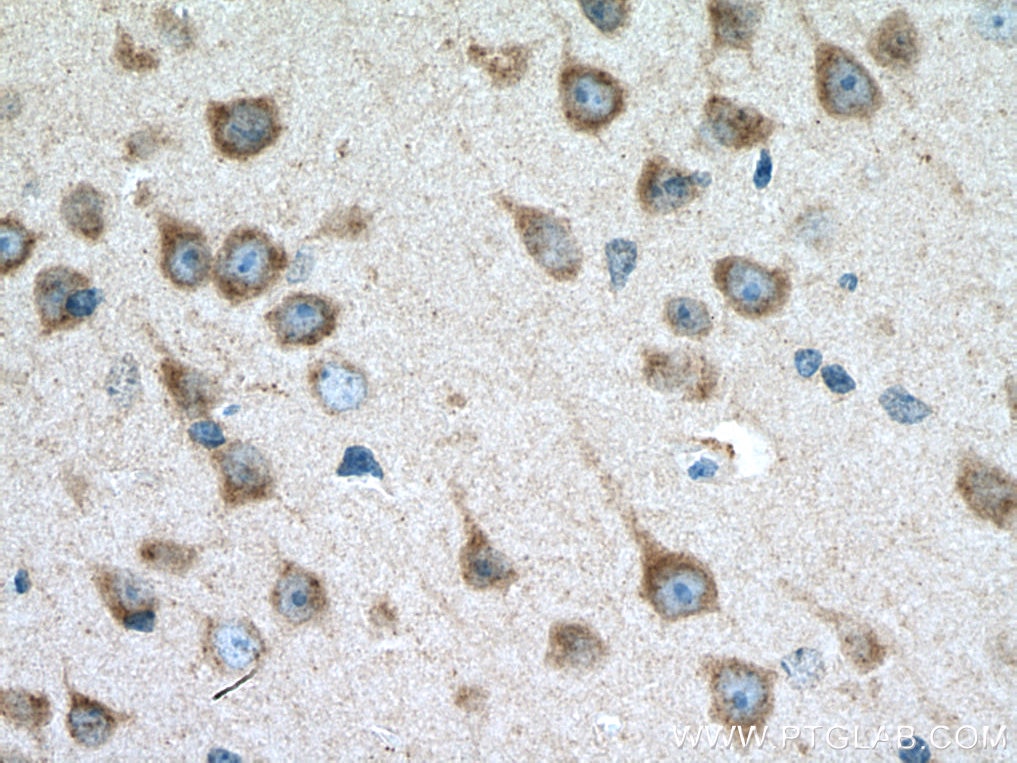Calsyntenin-1 Polyklonaler Antikörper
Calsyntenin-1 Polyklonal Antikörper für WB, IP, IHC, ELISA
Wirt / Isotyp
Kaninchen / IgG
Getestete Reaktivität
human, Maus, Ratte
Anwendung
WB, IP, IF, IHC, ELISA
Konjugation
Unkonjugiert
Kat-Nr. : 12788-1-AP
Synonyme
Galerie der Validierungsdaten
Geprüfte Anwendungen
| Erfolgreiche Detektion in WB | humanes Hirngewebe |
| Erfolgreiche IP | Maushirngewebe |
| Erfolgreiche Detektion in IHC | Maushirngewebe Hinweis: Antigendemaskierung mit TE-Puffer pH 9,0 empfohlen. (*) Wahlweise kann die Antigendemaskierung auch mit Citratpuffer pH 6,0 erfolgen. |
Empfohlene Verdünnung
| Anwendung | Verdünnung |
|---|---|
| Western Blot (WB) | WB : 1:500-1:2400 |
| Immunpräzipitation (IP) | IP : 0.5-4.0 ug for 1.0-3.0 mg of total protein lysate |
| Immunhistochemie (IHC) | IHC : 1:50-1:500 |
| It is recommended that this reagent should be titrated in each testing system to obtain optimal results. | |
| Sample-dependent, check data in validation data gallery | |
Veröffentlichte Anwendungen
| WB | See 5 publications below |
| IHC | See 1 publications below |
| IF | See 1 publications below |
Produktinformation
12788-1-AP bindet in WB, IP, IF, IHC, ELISA Calsyntenin-1 und zeigt Reaktivität mit human, Maus, Ratten
| Getestete Reaktivität | human, Maus, Ratte |
| In Publikationen genannte Reaktivität | human, Maus, Ratte |
| Wirt / Isotyp | Kaninchen / IgG |
| Klonalität | Polyklonal |
| Typ | Antikörper |
| Immunogen | Calsyntenin-1 fusion protein Ag3504 |
| Vollständiger Name | calsyntenin 1 |
| Berechnetes Molekulargewicht | 109 kDa |
| Beobachtetes Molekulargewicht | 109-130 kDa |
| GenBank-Zugangsnummer | BC033902 |
| Gene symbol | Calsyntenin-1 |
| Gene ID (NCBI) | 22883 |
| Konjugation | Unkonjugiert |
| Form | Liquid |
| Reinigungsmethode | Antigen-Affinitätsreinigung |
| Lagerungspuffer | PBS mit 0.02% Natriumazid und 50% Glycerin pH 7.3. |
| Lagerungsbedingungen | Bei -20°C lagern. Nach dem Versand ein Jahr lang stabil Aliquotieren ist bei -20oC Lagerung nicht notwendig. 20ul Größen enthalten 0,1% BSA. |
Hintergrundinformationen
Calsyntenins (calsyntenin-1, -2, -3) compose a family of neuronally expressed proteins that belong to the cadherin superfamily of cell adhesion molecules (PMID: 24966372; 12498782). Calsyntenin-1 (CLSTN1) is a proteolytically processed postsynaptic membrane protein with a cytoplasmic calcium-binding domain. By binding Ca2+, calsyntenin-1 may modulate Ca2+-mediated postsynaptic signals (PMID: 11161476). Calsyntenin-1 is a transmembrane cargo-docking protein for Kinesin-1-mediated vesicular transport (PMID: 16760430). It can mediate axonal transport of the amyloid precursor protein and regulate Aβ production (PMID: 22434822).
Protokolle
| Produktspezifische Protokolle | |
|---|---|
| WB protocol for Calsyntenin-1 antibody 12788-1-AP | Protokoll herunterladen |
| IHC protocol for Calsyntenin-1 antibody 12788-1-AP | Protokoll herunterladen |
| IP protocol for Calsyntenin-1 antibody 12788-1-AP | Protokoll herunterladen |
| Standard-Protokolle | |
|---|---|
| Klicken Sie hier, um unsere Standardprotokolle anzuzeigen |
Publikationen
| Species | Application | Title |
|---|---|---|
J Neurosci The cleavage products of amyloid-beta precursor protein are sorted to distinct carrier vesicles that are independently transported within neurites. | ||
Front Oncol Long Non-coding RNA AK025387 Promotes Cell Migration and Invasion of Gastric Cancer. | ||
Cardiovasc Drugs Ther Calsyntenin-1 Promotes Doxorubicin-induced Dilated Cardiomyopathy in Rats | ||
Cell Death Discov ESRP1-driven alternative splicing of CLSTN1 inhibits the metastasis of gastric cancer | ||
J Cancer Res Clin Oncol Explore the alterations of downstream molecular pathways caused by ARID1A mutation/knockout in human endometrial cancer cells |
Rezensionen
The reviews below have been submitted by verified Proteintech customers who received an incentive for providing their feedback.
FH Boyan (Verified Customer) (12-09-2019) | This antibody gave a clean band around 100 kD, like that is shown in its datasheet. However, in literature, people showed that this protein runs as doublet bands at 130 - 150 kD due to its glycosylation. Therefore, this antibody is highly suspicious for recognizing another protein rather than Clstn1 itself.
|





